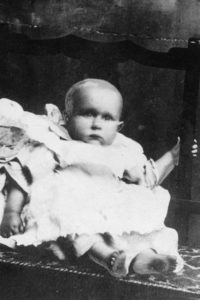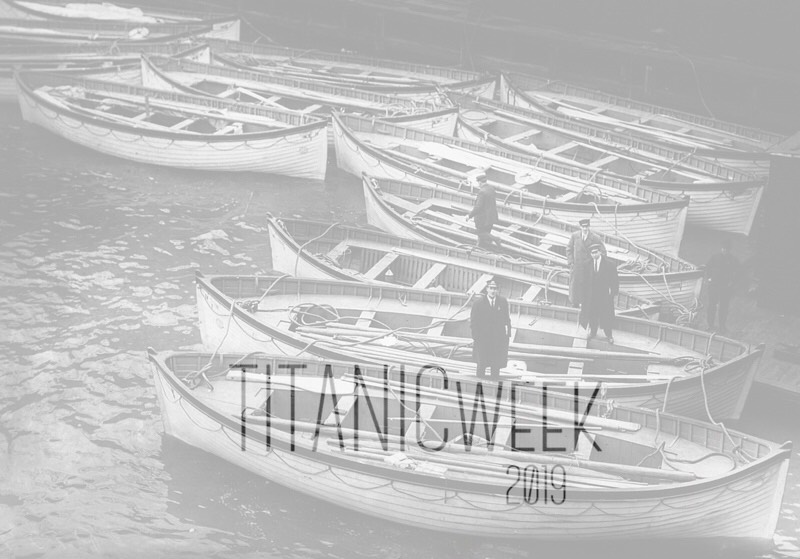"Our Babe": The Mystery of Titanic's 'Unknown Child'
Clifford Crease was 24 years old when he and his crewmates embarked on the grimmest journey of their lives: collecting the dead from Titanic.

The crew of the Mackay-Bennett recovers a Titanic victim.
The Mackay-Bennett arrived to the site on the night of April 19, and saw that there were far more bodies than anyone could have anticipated.
At 6:00 a.m. on April 20, their work began.
All crew on the Mackay-Bennett were required to keep a log or diary of their gruesome task in the wake of Titanic. Only Clifford's, which has been donated, and one other are known to remain in existence.
One by one, small skiff boats were dispatched from the Mackay-Bennett, where they began manually pulling corpses from the water, to describe their faces and rifle through their pockets.
It had already been almost a week that they'd been bobbing in the water, exposed to the elements and ships passing through the massive debris field. Most of the bodies were mangled from the sinking--lacerated, bruised, many with broken bones.
(Please take a moment to reflect on how traumatic this reaping truly was. The men on board the Mackay-Bennett never get the credit they deserve.)
After the third body, a female third-class passenger, had been pulled aboard and catalogued, Clifford Crease's work turned from solemn to sorrowful.
Over the side of the boat, he scooped up a fourth body. Tiny. Blond, ocean-pale, and eerily still. Unlike the corpses all around them, this body was pristine--more doll than person, we might imagine. Clifford cradled the dead baby boy in what seemed like interminable silence.
After searching for identification and finding none, they reverently noted the baby as follows.
NO. 4 - MALE - ESTIMATED AGE, 2 - HAIR, FAIR
CLOTHING - Grey coat with fur on collar and cuffs; brown serge frock; petticoat; flannel garment; pink woolen singlet - brown shoes and stockings.
NO MARKS WHATEVER
PROBABLY THIRD CLASS
Clifford and his mates were in shock.
Back on board the Mackay-Bennett, the decision had been made to bury steerage passengers at sea, owing to a lack of space and shortage of embalming fluid. So only the First and Second Classes were embalmed or put on ice and returned to Halifax.
An exception was made for the nameless baby that was "probably third class." No one could bring themselves to commit him to the sea, all alone forever.
After recovering a total of 306 bodies from the site, the Mackay-Bennett returned to Halifax. Bodies were distributed to funeral homes, morgues, and grieving families. Photos were taken. Days passed.
But no one claimed the baby.

Hearses queued at Halifax Wharf, waiting to transport the corpses of Titanic victims to local funeral parlors. Courtesy of Nova Scotia Archives & Records Management (NSARM).
The sailors who had been on board the Mackay-Bennett that nightmarish day then took matters into their own hands and adopted the child in death. Spearheaded by Clifford Crease, they arranged a funeral and pooled their wages for a small coffin and headstone.
In the coffin, they placed a brass plate engraved with two words: "Our babe."
Clifford acted as one of the baby's pallbearers.
The Unknown Child now rested in the Halifax's Fairview Cemetery. Suspecting that his identity might be that of 2-year-old Gosta Palsson, youngest son of Third-Class passenger Alma Palsson, he was interred in close proximity to her grave.
Years went by, and Clifford could never bring himself to forget The Unknown Child. Every year on the anniversary of the sinking, he laid a wreath on the grave.
And when Clifford Crease died in 1961, he was interred mere meters away from the child who had haunted him all of his life.
According to his family, Clifford didn't speak about his grim time on the Mackay-Bennett until the end of his life, prompted by a program he was watching on television about Walter Lord's "A Night to Remember." According to Clifford's granddaughter, "He never fully recovered... He told our father it was the worst thing that ever happened to him."
In 2001, two Canadian scientists named Ryan Parr and Alan Ruffman collaborated in order to find the identity of Titanic's Unknown Child.
They exhumed the remains, but there was nothing left other than a fragment of an arm bone, and three little teeth. Mercifully, the plate laid in the coffin by the crew of the Mackay-Bennett had protected these scarce remains. And miraculously, that was enough.
The remains were not a match to the Palsson family, who had originally given permission for the remains to be disinterred. They expanded the scope of their candidates from among 5 boys under the age of 3 who had died on Titanic.
In addition to Gosta Palsson, there were:
Gilbert Danbom 5 months old, from Sweden
Alfred Peacock 7 months old, from England
Eino Panula 13 months old, from Finland
Sidney Goodwin 19 months old, from England
Eugene Rice 2 years old, from Ireland
With the long-term assistance of geneaologists and historians, as well as willing descendants, Ruffman and Parr tracked down genetic samples from all 5 families of the little boys.
From the candidates remaining after Gosta Palsson was ruled out, 3 were evident non-matches; this left only Sidney Goodwin and Eino Panula as the possible Unknown Child, due to a shared mutation in their mitochondrial DNA.
Looking at the teeth that had been recovered from the grave, the scientists determined that they'd belonged to a child in the 9-15 month range. By process of elimination, Ruffman and Parr published their results: The Unknown Child was 13-month-old Eino, whose family was traveling from Finland.
It was accepted by the majority that the Unknown Child finally had a name.
But some, including Parr and Ruffman, suspected it was the incorrect one.
All because of a pair of shoes.
In 2007, Dr. Parr admitted that they may have made a mistake.
Back in 2002, a man named Earle Northover had donated a pair of brown-leather baby shoes to the Maritime Museum of the Atlantic. They had belonged, he said, to the Unknown Child.
According to Earle, the wee shoes had been removed from the baby, and saved from destruction by his grandfather Clarence Northover, a sargeant for the Halifax Police Department. Earle wrote the following in his letter to the Museum.
Clothing was burned to stop souvenir hunters but he was too emotional when he saw the little pair of brown, leather shoes about fourteen centimeters long, and didn’t have the heart to burn them. When no relatives came to claim the shoes, he placed them in his desk drawer at the police station and there they remained for the next six years, until he retired in 1918.
The shoes, Dr. Parr thought, were too big for a 13-month-old to wear. So they retested the DNA samples with the U.S. Armed Forces Identification Laboratory, where the team isolated a single, but significant and rare, genetic distinction.
With around a 98% certainty, Parr's team amended their previous results.
Thanks to the little shoes hidden in Sargeant Northover's desk drawer, the Uknown Child was identified as Sidney Goodwin.

Sidney Goodwin, Titanic's Unknown Child.
At 19 months old, Sidney was the youngest of six children. His entire family was traveling from England to America where their father, Frederick, was set to have a new job at the new power station in Niagara Falls.
The Goodwins had planned to set to sail on the S.S. New York, but were transferred to Titanic as a result of the coal miners' strike.
All eight members of the Goodwin family--both parents, and all of their children--died when Titanic sank.
Aside from Sidney, who would spend almost a century unidentified, no member of the Goodwin family was recovered.

Sidney Goodwin's parents and five older siblings circa 1910. The entire family died in the sinking.
The Goodwin descendants held a memorial service at the grave of The Unknown Child on August 6, 2008. One by one, they read the name of each child lost on Titanic out loud, ringing a bell for each.
The family elected to leave the headstone installed by the crew of the Mackay-Bennett.
As a Goodwin cousin said in an interview, "The tombstone of the unknown child represents all of the children who perished on the Titanic, and we left it that way."
SOURCE MATERIAL
https://novascotia.ca/archives/titanic/archives.asp?ID=3&Page=201111292&Language
https://maritimemuseum.novascotia.ca/titanic-shoes
https://identifinders.wordpress.com/2010/08/14/unknown-child-on-the-titanic-part-i/
https://www.livescience.com/13859-titanic-unknown-child-identification-sidney-goodwin.html


